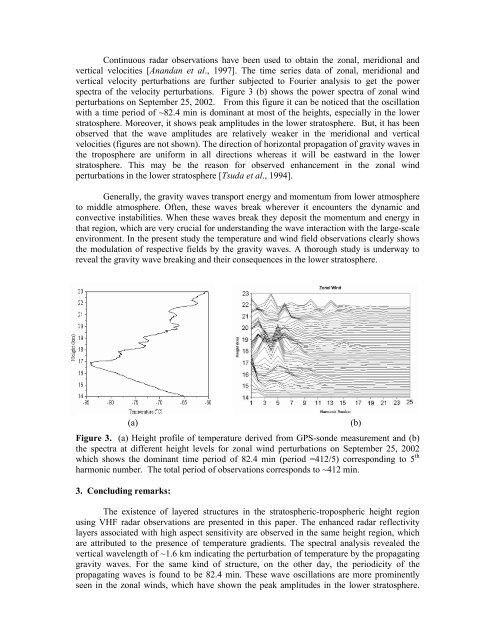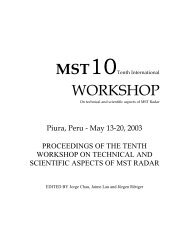vhf-radar observations of temperature sheets in the stratospheric ...
vhf-radar observations of temperature sheets in the stratospheric ...
vhf-radar observations of temperature sheets in the stratospheric ...
Create successful ePaper yourself
Turn your PDF publications into a flip-book with our unique Google optimized e-Paper software.
Cont<strong>in</strong>uous <strong>radar</strong> <strong>observations</strong> have been used to obta<strong>in</strong> <strong>the</strong> zonal, meridional andvertical velocities [Anandan et al., 1997]. The time series data <strong>of</strong> zonal, meridional andvertical velocity perturbations are fur<strong>the</strong>r subjected to Fourier analysis to get <strong>the</strong> powerspectra <strong>of</strong> <strong>the</strong> velocity perturbations. Figure 3 (b) shows <strong>the</strong> power spectra <strong>of</strong> zonal w<strong>in</strong>dperturbations on September 25, 2002. From this figure it can be noticed that <strong>the</strong> oscillationwith a time period <strong>of</strong> ~82.4 m<strong>in</strong> is dom<strong>in</strong>ant at most <strong>of</strong> <strong>the</strong> heights, especially <strong>in</strong> <strong>the</strong> lowerstratosphere. Moreover, it shows peak amplitudes <strong>in</strong> <strong>the</strong> lower stratosphere. But, it has beenobserved that <strong>the</strong> wave amplitudes are relatively weaker <strong>in</strong> <strong>the</strong> meridional and verticalvelocities (figures are not shown). The direction <strong>of</strong> horizontal propagation <strong>of</strong> gravity waves <strong>in</strong><strong>the</strong> troposphere are uniform <strong>in</strong> all directions whereas it will be eastward <strong>in</strong> <strong>the</strong> lowerstratosphere. This may be <strong>the</strong> reason for observed enhancement <strong>in</strong> <strong>the</strong> zonal w<strong>in</strong>dperturbations <strong>in</strong> <strong>the</strong> lower stratosphere [Tsuda et al., 1994].Generally, <strong>the</strong> gravity waves transport energy and momentum from lower atmosphereto middle atmosphere. Often, <strong>the</strong>se waves break wherever it encounters <strong>the</strong> dynamic andconvective <strong>in</strong>stabilities. When <strong>the</strong>se waves break <strong>the</strong>y deposit <strong>the</strong> momentum and energy <strong>in</strong>that region, which are very crucial for understand<strong>in</strong>g <strong>the</strong> wave <strong>in</strong>teraction with <strong>the</strong> large-scaleenvironment. In <strong>the</strong> present study <strong>the</strong> <strong>temperature</strong> and w<strong>in</strong>d field <strong>observations</strong> clearly shows<strong>the</strong> modulation <strong>of</strong> respective fields by <strong>the</strong> gravity waves. A thorough study is underway toreveal <strong>the</strong> gravity wave break<strong>in</strong>g and <strong>the</strong>ir consequences <strong>in</strong> <strong>the</strong> lower stratosphere.(a)Figure 3. (a) Height pr<strong>of</strong>ile <strong>of</strong> <strong>temperature</strong> derived from GPS-sonde measurement and (b)<strong>the</strong> spectra at different height levels for zonal w<strong>in</strong>d perturbations on September 25, 2002which shows <strong>the</strong> dom<strong>in</strong>ant time period <strong>of</strong> 82.4 m<strong>in</strong> (period =412/5) correspond<strong>in</strong>g to 5 thharmonic number. The total period <strong>of</strong> <strong>observations</strong> corresponds to ~412 m<strong>in</strong>.3. Conclud<strong>in</strong>g remarks:The existence <strong>of</strong> layered structures <strong>in</strong> <strong>the</strong> <strong>stratospheric</strong>-tropospheric height regionus<strong>in</strong>g VHF <strong>radar</strong> <strong>observations</strong> are presented <strong>in</strong> this paper. The enhanced <strong>radar</strong> reflectivitylayers associated with high aspect sensitivity are observed <strong>in</strong> <strong>the</strong> same height region, whichare attributed to <strong>the</strong> presence <strong>of</strong> <strong>temperature</strong> gradients. The spectral analysis revealed <strong>the</strong>vertical wavelength <strong>of</strong> ~1.6 km <strong>in</strong>dicat<strong>in</strong>g <strong>the</strong> perturbation <strong>of</strong> <strong>temperature</strong> by <strong>the</strong> propagat<strong>in</strong>ggravity waves. For <strong>the</strong> same k<strong>in</strong>d <strong>of</strong> structure, on <strong>the</strong> o<strong>the</strong>r day, <strong>the</strong> periodicity <strong>of</strong> <strong>the</strong>propagat<strong>in</strong>g waves is found to be 82.4 m<strong>in</strong>. These wave oscillations are more prom<strong>in</strong>entlyseen <strong>in</strong> <strong>the</strong> zonal w<strong>in</strong>ds, which have shown <strong>the</strong> peak amplitudes <strong>in</strong> <strong>the</strong> lower stratosphere.(b)
















